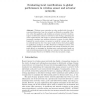Free Online Productivity Tools
i2Speak
i2Symbol
i2OCR
iTex2Img
iWeb2Print
iWeb2Shot
i2Type
iPdf2Split
iPdf2Merge
i2Bopomofo
i2Arabic
i2Style
i2Image
i2PDF
iLatex2Rtf
Sci2ools
DCOSS
2006
Springer
2006
Springer
Evaluating Local Contributions to Global Performance in Wireless Sensor and Actuator Networks
Wireless sensor networks are often studied with the goal of removing information from the network as efficiently as possible. However, when the application also includes an actuator network, it is advantageous to determine actions in-network. In such settings, optimizing the sensor node behavior with respect to sensor information fidelity does not necessarily translate into optimum behavior in terms of action fidelity. Inspired by neural systems, we present a model of a sensor and actuator network based on the vector space tools of frame theory that applies to applications analogous to reflex behaviors in biological systems. Our analysis yields bounds on both absolute and average actuation error that point directly to strategies for limiting sensor communication based not only on local measurements but also on a measure of how important each sensor-actuator link is to the fidelity of the total actuation output.
Actuator Network | DCOSS 2006 | Distributed And Parallel Computing | Sensor | Wireless Sensor Networks |
Related Content
| Added | 22 Aug 2010 |
| Updated | 22 Aug 2010 |
| Type | Conference |
| Year | 2006 |
| Where | DCOSS |
| Authors | Christopher J. Rozell, Don H. Johnson |
Comments (0)

